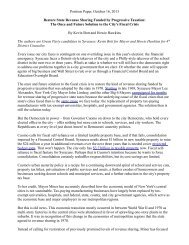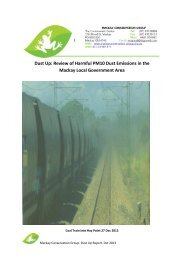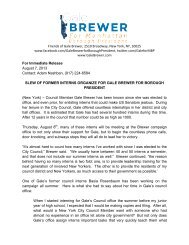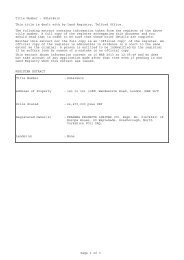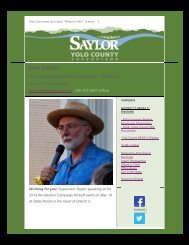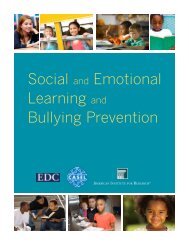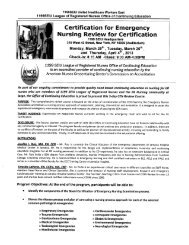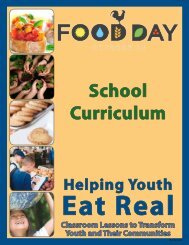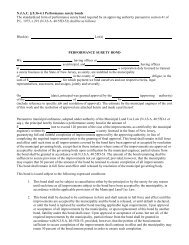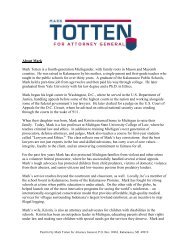Create successful ePaper yourself
Turn your PDF publications into a flip-book with our unique Google optimized e-Paper software.
Lesson 4: Navigate the Environment<br />
— Core Activity —<br />
Procedure<br />
1. Review the <strong>Food</strong> <strong>Day</strong> Eating Goals<br />
Review the <strong>Food</strong> <strong>Day</strong> Eating Goals of: “Eat Real,” “Mostly Plants,” and “Not Too Much.” Ask the<br />
students to share how they are doing on their action plans. Remind students that following these<br />
goals is important for their personal health and the health of the environment. Yet, making changes<br />
can be really challenging. Make a list of some of the challenges students have faced on chart paper.<br />
These challenges might include: taste (not liking vegetables), habits, being enticed by advertisements,<br />
ready availability to overly processed foods, and limited availability to whole plant foods.<br />
Aim<br />
To discover the challenges<br />
and the opportunities in our<br />
food environment and create<br />
a plan for how to navigate<br />
through the environment to<br />
meet the <strong>Food</strong> <strong>Day</strong> Eating<br />
Goals.<br />
Materials<br />
• online map of area around<br />
your school<br />
• chart paper and markers<br />
• <strong>Food</strong> Environment cards<br />
• Seeking Out Real <strong>Food</strong><br />
Action Plan activity sheet<br />
Before You Begin<br />
• Get an online map, using<br />
google maps or another<br />
on-line map, of the area<br />
around your school. Be sure<br />
your map includes an area<br />
big enough to have several<br />
venues to obtain food. In<br />
an urban area, your map<br />
might be an area of about 10<br />
blocks. In a rural area, your<br />
map might cover several<br />
miles.<br />
• Print and make copies of<br />
the Seeking Out Real <strong>Food</strong><br />
Action Plan activity sheet<br />
for each student.<br />
2. Introduce the <strong>Food</strong> Environment<br />
Write “<strong>Food</strong> Environment” in the middle of a sheet of chart paper. Ask students to share ideas about<br />
what they think food environment means. Accept all answers. Explain that the food environment is<br />
the actual food that is available to us (e.g., food we can get from grocery stores, vending machines,<br />
food stands/trucks, restaurants) and messages we get about food (e.g. advertisements we see on TV,<br />
billboards, and bus stops or a bumper sticker that says “support farmers, eat local”). Use the <strong>Food</strong><br />
Environment cards to show positive and negative examples of our current food environment.<br />
3. Investigate Your Community <strong>Food</strong> Environment<br />
Project (if you can) and distribute the online map of the area around your school. Have the students<br />
look at the map and think about places they can get food. Draw and write onto the map to indicate<br />
these places. For each location, discuss what whole foods are available and what types of overly<br />
processed foods are available. If you have a school or community garden near your school, be sure<br />
this is also indicated on the map. Please note that you will use this map again in Lesson 5, when you<br />
come up with ideas you can do to advocate for positive changes in your environment. Therefore, it is<br />
important to make the map as complete as you can.<br />
4. Highlight Opportunities to Meet the <strong>Food</strong> <strong>Day</strong> Goals<br />
Look at the map and have students find places where they have opportunities to meet the <strong>Food</strong> <strong>Day</strong><br />
Eating Goals (places with real food) and mark these places with a crayon, marker, or colored pencil<br />
on their map. Be sure to mark all venues that offer fresh fruits and vegetables (such as supermarkets,<br />
farmers’ markets, fruit stands, and corner stores) and restaurants that serve simple, basic wholesome<br />
meals, and gardens that are growing food. If you offer plant-based snacks and other whole foods<br />
in your classroom, mark your classroom. Also, school meals offer fruit at breakfast and fruits and<br />
vegetables at lunch. Explain that seeking out these positive opportunities is navigating through the<br />
food environment and not letting the challenges of the food environment get the best of us. Once<br />
you have the places marked on the map, write the names of each place on chart paper. Have students<br />
list some of the health-promoting options offered at each place. This list will help them make their<br />
action plans.<br />
5. Create Navigating the Environment Action Plans<br />
Distribute the Seeking Out Real <strong>Food</strong> Action Plan activity sheet. Have students look at the list<br />
of places you just created. Explain that in this action plan, they are going make a plan to seek out<br />
something on the list they typically do not eat. They can eat this health-promoting food instead of a<br />
highly processed food. For example, a student might skip eating at a fast food place and have a whole<br />
grain cereal topped with fresh fruit at home; skip the overly processed, packaged cupcake and stop<br />
by the farmers’ market to grab some freshly harvested fruit or a homemade muffin. This action plan<br />
could be a recommitment to their Eat Real Action Plan from Lesson 1, or something new to try.<br />
Remind students that change is hard and takes time and work. We create action plans that help us<br />
create a trigger that contributes to making positive changes.<br />
<strong>Food</strong> <strong>Day</strong> Lessons | 55



